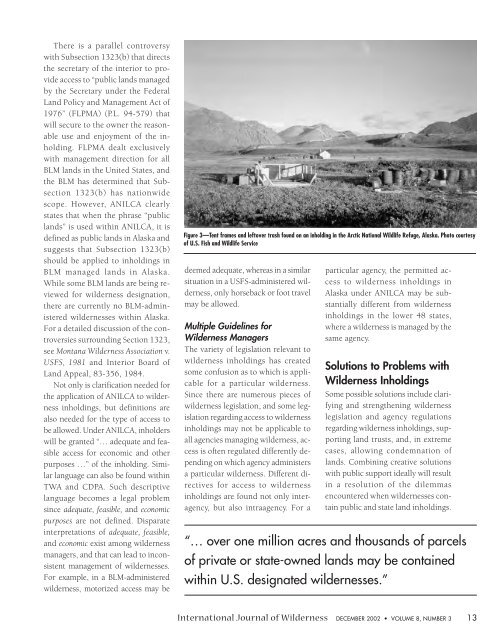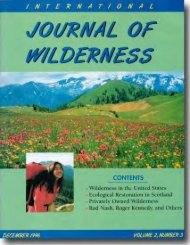Download full PDF - International Journal of Wilderness
Download full PDF - International Journal of Wilderness
Download full PDF - International Journal of Wilderness
You also want an ePaper? Increase the reach of your titles
YUMPU automatically turns print PDFs into web optimized ePapers that Google loves.
There is a parallel controversy<br />
with Subsection 1323(b) that directs<br />
the secretary <strong>of</strong> the interior to provide<br />
access to “public lands managed<br />
by the Secretary under the Federal<br />
Land Policy and Management Act <strong>of</strong><br />
1976” (FLPMA) (P.L. 94-579) that<br />
will secure to the owner the reasonable<br />
use and enjoyment <strong>of</strong> the inholding.<br />
FLPMA dealt exclusively<br />
with management direction for all<br />
BLM lands in the United States, and<br />
the BLM has determined that Subsection<br />
1323(b) has nationwide<br />
scope. However, ANILCA clearly<br />
states that when the phrase “public<br />
lands” is used within ANILCA, it is<br />
defined as public lands in Alaska and<br />
suggests that Subsection 1323(b)<br />
should be applied to inholdings in<br />
BLM managed lands in Alaska.<br />
While some BLM lands are being reviewed<br />
for wilderness designation,<br />
there are currently no BLM-administered<br />
wildernesses within Alaska.<br />
For a detailed discussion <strong>of</strong> the controversies<br />
surrounding Section 1323,<br />
see Montana <strong>Wilderness</strong> Association v.<br />
USFS, 1981 and Interior Board <strong>of</strong><br />
Land Appeal, 83-356, 1984.<br />
Not only is clarification needed for<br />
the application <strong>of</strong> ANILCA to wilderness<br />
inholdings, but definitions are<br />
also needed for the type <strong>of</strong> access to<br />
be allowed. Under ANILCA, inholders<br />
will be granted “… adequate and feasible<br />
access for economic and other<br />
purposes …” <strong>of</strong> the inholding. Similar<br />
language can also be found within<br />
TWA and CDPA. Such descriptive<br />
language becomes a legal problem<br />
since adequate, feasible, and economic<br />
purposes are not defined. Disparate<br />
interpretations <strong>of</strong> adequate, feasible,<br />
and economic exist among wilderness<br />
managers, and that can lead to inconsistent<br />
management <strong>of</strong> wildernesses.<br />
For example, in a BLM-administered<br />
wilderness, motorized access may be<br />
Figure 3—Tent frames and leftover trash found on an inholding in the Arctic National Wildlife Refuge, Alaska. Photo courtesy<br />
<strong>of</strong> U.S. Fish and Wildlife Service<br />
deemed adequate, whereas in a similar<br />
situation in a USFS-administered wilderness,<br />
only horseback or foot travel<br />
may be allowed.<br />
Multiple Guidelines for<br />
<strong>Wilderness</strong> Managers<br />
The variety <strong>of</strong> legislation relevant to<br />
wilderness inholdings has created<br />
some confusion as to which is applicable<br />
for a particular wilderness.<br />
Since there are numerous pieces <strong>of</strong><br />
wilderness legislation, and some legislation<br />
regarding access to wilderness<br />
inholdings may not be applicable to<br />
all agencies managing wilderness, access<br />
is <strong>of</strong>ten regulated differently depending<br />
on which agency administers<br />
a particular wilderness. Different directives<br />
for access to wilderness<br />
inholdings are found not only interagency,<br />
but also intraagency. For a<br />
particular agency, the permitted access<br />
to wilderness inholdings in<br />
Alaska under ANILCA may be substantially<br />
different from wilderness<br />
inholdings in the lower 48 states,<br />
where a wilderness is managed by the<br />
same agency.<br />
Solutions to Problems with<br />
<strong>Wilderness</strong> Inholdings<br />
Some possible solutions include clarifying<br />
and strengthening wilderness<br />
legislation and agency regulations<br />
regarding wilderness inholdings, supporting<br />
land trusts, and, in extreme<br />
cases, allowing condemnation <strong>of</strong><br />
lands. Combining creative solutions<br />
with public support ideally will result<br />
in a resolution <strong>of</strong> the dilemmas<br />
encountered when wildernesses contain<br />
public and state land inholdings.<br />
“… over one million acres and thousands <strong>of</strong> parcels<br />
<strong>of</strong> private or state-owned lands may be contained<br />
within U.S. designated wildernesses.”<br />
<strong>International</strong> <strong>Journal</strong> <strong>of</strong> <strong>Wilderness</strong> DECEMBER 2002 • VOLUME 8, NUMBER 3 13










